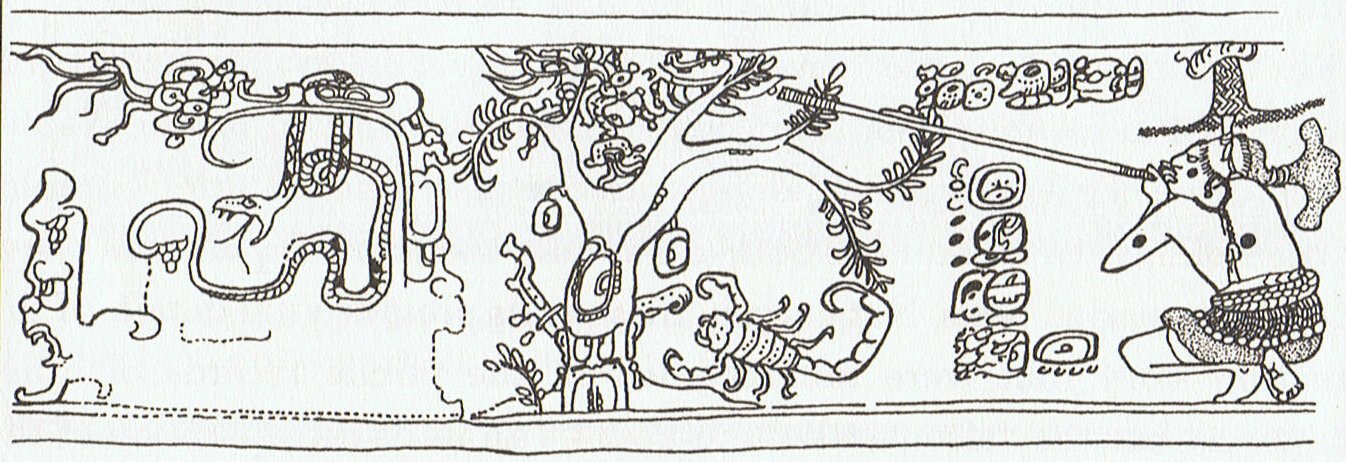|
Futuna month names: |
My comments: | |
| 1 December | Vai-mua | Vaitu nui and Vaitu potu are April and May on Easter Island (according to Barthel 2). |
| 2 January | Vai-muli | |
| 3 February | Lisa-mua / Lisa-muli | Riha means slow (as if having eaten to satisfaction), which would be a good name for the time of Saturn at the end of the year (heavy as lead and satisfied). |
| 4 March | Fakaafu-ola | Haka-ahu means to make a grave. Ora is life and mate is death. |
| 5 April | Fakaafu-mate | |
| 6 May | Ualoa | Ua-roa (also an expression with Metoro) could mean the great (or long) rain. |
| 7 June | Tula-lupe | Hawaiian kula means the open country back of the sea-shore, uncultivated land. Rupe is Tahitian for pigeon. On Hawaii it means a kite. Fiji has rube, to hang up, suspend. |
| 8 July | Mataliki | The Pleiades. |
| 9 August | Tolu | 3 |
| 10 September | Palolo-mua | The Palolo season on Samoa was their wet season (October-March). |
| 11 October | Palolo-muli | |
| 12 November | Munifa | Ha means 4 (but also to yawn etc). Muni could be a wordplay on muli. Munifa is the last (muri) month of the 4th quarter. Ni could allude to e.g. niu. |
| Extra month | Tau-afu | Tau could mean year, i.e. the grave of the year. |
|
Remarks and imaginations: I guess that in a way December-June was the first part and July-November the second part of the year. Counting together Vai-mua with Vai-muli and Palolo-mua with Palolo-muli the number of regular months will shrink from 12 to 10. Furthermore, Fakaafu-ola and Fakaafu-mate presumably should also be counted together, in which case the number of regular months will be as low as 9 (= 5 + 4, cfr the picture from the grave in Egypt). On the other hand, if we separate Lisa-mua and Lisa-muli the number will instead increase from 12 to 13. With the pattern 5 + 4 Tula-lupe will be seen as the last month of the 'front side' and Mataliki the first month of the 'back side'. Tau in Tau-afu, the extra month, can possibly be read as the place where the 'sun bird' is perching (tau) in his tree. Considering the Fijian rube (to hang up, suspend) we can guess there is also a tree branch for the 'pigeon' (lupe) to perch on at Tula-lupe. The cosmic tree is encountered both at the top and the bottom of the year. According to Popol Vuh the bird at the top is Seven-Macaw:
Orion is rising slightly after the Pleiades (Matariki) and for the Maya the Turtle was 'hanging' below the ecliptic. The Mayan Turtle with 3 stones was the Belt of Orion, which could explain Tolu - if we consider Tula-lupe, Mataliki and Tolu as a group (Tula and Tolu are forming a wordplay pair). Classical writers said Orion the mighty hunter was 'blind', and the 3 stones could allude to a missing 'fire'. Gemini comes after Orion and the twin months Palolo-mua and Palolo-muli come after Tolu. The logic of time order will force us to say that tula in Tula-lupe means that there are no prominent constellations (no 'fire') before Mataliki (the little 'eyes'). A new 'year' is therefore beginning with the Pleiades. Orion was seen as a bird snare by the Maori, a place where the 'bird' got stuck and couldn't move away: "Pewa-o-Tautoru, Bird-snare-of-Tautoru; the constellation Orion in New Zealand. The Belt and Sword form the perch, te mutu or te teke, while Rigel is the blossom cluster, Puanga, used to entice the unsuspecting bird. To visualize the bird-snare we must remember that Orion, as we see it in the northern hemisphere, is upside down to the view obtained from New Zealand where Orion stands in the northern sky." (Makemson)
(Picture from Text Centre) Makemsons remark also means that for the Maori the belt stars were not down in the 'water' (below the ecliptic) but up on 'land'. Ua-roa indicates 'water', Tula-lupu refers to 'air', and 'land' is definitely reached with Mataliki. There are 3 double-months before Ua-roa and these could indicate the 'front side'. From Mataliki we can count 4 (or 5) regular months (for the 'back side'). 8 (or 5) months are needed before 'land' arrives with Mataliki. Tula-lupe could correspond to Te Pei and Te Pou (Sirius) could correspond to Tolu - also the kuhane station Te Pou lies in July (according to Barthel 2). Maybe Sirius (Reitaga on Easter Island) was imagined as the 'pigeon' caught in the snare. Its fame is based not only on brightness but also on its power to remain standing still in spite of the precession (at least in ancient Egyptian times). Taga means 'sack'. The form of the bird snare 'stick' is not very far from the shape of a toki. |
||

